Rajarshi Roy Chowdhury
Communication Traffic Characteristics Reveal an IoT Devices Identity
Feb 25, 2024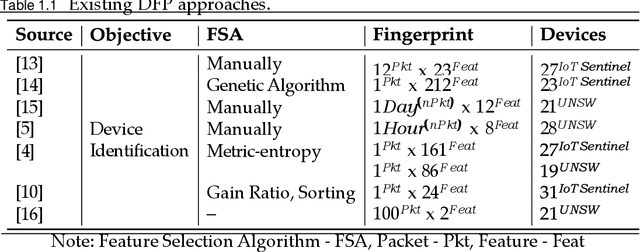


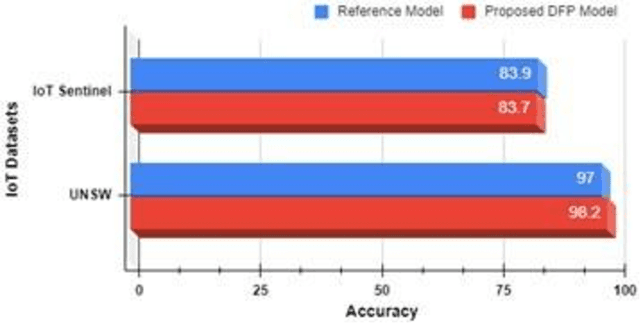
Abstract:Internet of Things (IoT) is one of the technological advancements of the twenty-first century which can improve living standards. However, it also imposes new types of security challenges, including device authentication, traffic types classification, and malicious traffic identification, in the network domain. Traditionally, internet protocol (IP) and media access control (MAC) addresses are utilized for identifying network-connected devices in a network, whilst these addressing schemes are prone to be compromised, including spoofing attacks and MAC randomization. Therefore, device identification using only explicit identifiers is a challenging task. Accurate device identification plays a key role in securing a network. In this paper, a supervised machine learning-based device fingerprinting (DFP) model has been proposed for identifying network-connected IoT devices using only communication traffic characteristics (or implicit identifiers). A single transmission control protocol/internet protocol (TCP/IP) packet header features have been utilized for generating unique fingerprints, with the fingerprints represented as a vector of 22 features. Experimental results have shown that the proposed DFP method achieves over 98% in classifying individual IoT devices using the UNSW dataset with 22 smart-home IoT devices. This signifies that the proposed approach is invaluable to network operators in making their networks more secure.
A Hypergraph-Based Approach to Recommend Online Resources in a Library
Dec 02, 2023

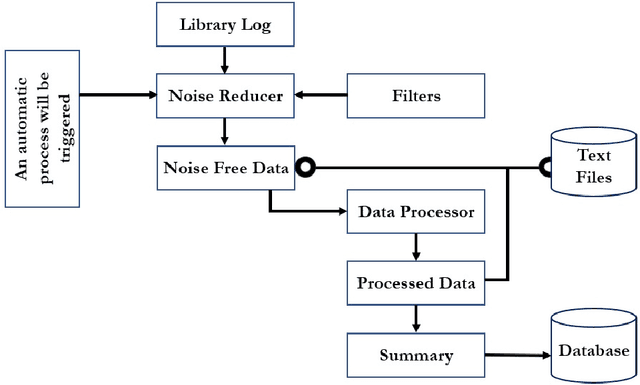
Abstract:When users in a digital library read or browse online resources, it generates an immense amount of data. If the underlying system can recommend items, such as books and journals, to the users, it will help them to find the related items. This research analyzes a digital library's usage data to recommend items to its users, and it uses different clustering algorithms to design the recommender system. We have used content-based clustering, including hierarchical, expectation maximization (EM), K-mean, FarthestFirst, and density-based clustering algorithms, and user access pattern-based clustering, which uses a hypergraph-based approach to generate the clusters. This research shows that the recommender system designed using the hypergraph algorithm generates the most accurate recommendation model compared to those designed using the content-based clustering approaches.
Internet of Things: Digital Footprints Carry A Device Identity
Jan 01, 2023Abstract:The usage of technologically advanced devices has seen a boom in many domains, including education, automation, and healthcare; with most of the services requiring Internet connectivity. To secure a network, device identification plays key role. In this paper, a device fingerprinting (DFP) model, which is able to distinguish between Internet of Things (IoT) and non-IoT devices, as well as uniquely identify individual devices, has been proposed. Four statistical features have been extracted from the consecutive five device-originated packets, to generate individual device fingerprints. The method has been evaluated using the Random Forest (RF) classifier and different datasets. Experimental results have shown that the proposed method achieves up to 99.8% accuracy in distinguishing between IoT and non-IoT devices and over 97.6% in classifying individual devices. These signify that the proposed method is useful in assisting operators in making their networks more secure and robust to security breaches and unauthorized access.
Device identification using optimized digital footprints
Dec 04, 2022Abstract:The rapidly increasing number of internet of things (IoT) and non-IoT devices has imposed new security challenges to network administrators. Accurate device identification in the increasingly complex network structures is necessary. In this paper, a device fingerprinting (DFP) method has been proposed for device identification, based on digital footprints, which devices use for communication over a network. A subset of nine features have been selected from the network and transport layers of a single transmission control protocol/internet protocol packet based on attribute evaluators in Weka, to generate device-specific signatures. The method has been evaluated on two online datasets, and an experimental dataset, using different supervised machine learning (ML) algorithms. Results have shown that the method is able to distinguish device type with up to 100% precision using the random forest (RF) classifier, and classify individual devices with up to 95.7% precision. These results demonstrate the applicability of the proposed DFP method for device identification, in order to provide a more secure and robust network.
Item Recommendation Using User Feedback Data and Item Profile
Jun 28, 2022
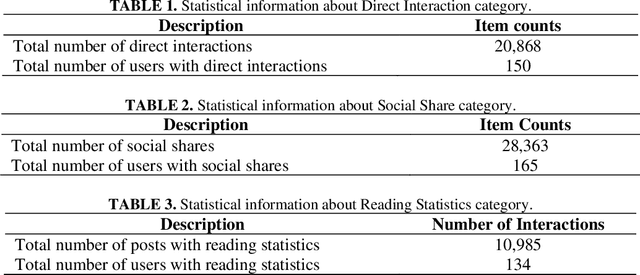
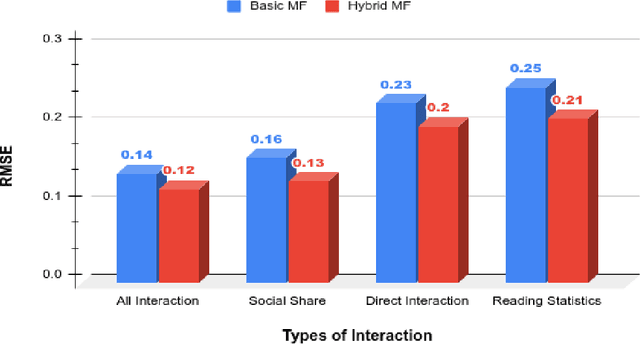
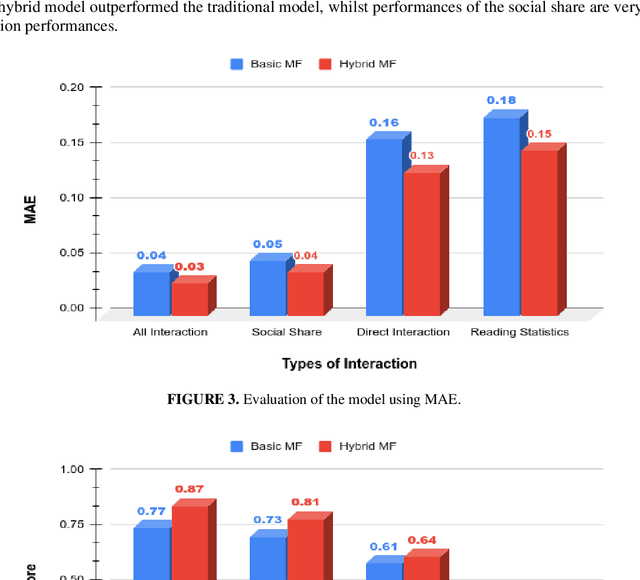
Abstract:Matrix factorization (MS) is a collaborative filtering (CF) based approach, which is widely used for recommendation systems (RS). In this research work, we deal with the content recommendation problem for users in a content management system (CMS) based on users' feedback data. The CMS is applied for publishing and pushing curated content to the employees of a company or an organization. Here, we have used the user's feedback data and content data to solve the content recommendation problem. We prepare individual user profiles and then generate recommendation results based on different categories, including Direct Interaction, Social Share, and Reading Statistics, of user's feedback data. Subsequently, we analyze the effect of the different categories on the recommendation results. The results have shown that different categories of feedback data have different impacts on recommendation accuracy. The best performance achieves if we include all types of data for the recommendation task. We also incorporate content similarity as a regularization term into an MF model for designing a hybrid model. Experimental results have shown that the proposed hybrid model demonstrates better performance compared with the traditional MF-based models.
Network Traffic Analysis based IoT Device Identification
Sep 10, 2020



Abstract:Device identification is the process of identifying a device on Internet without using its assigned network or other credentials. The sharp rise of usage in Internet of Things (IoT) devices has imposed new challenges in device identification due to a wide variety of devices, protocols and control interfaces. In a network, conventional IoT devices identify each other by utilizing IP or MAC addresses, which are prone to spoofing. Moreover, IoT devices are low power devices with minimal embedded security solution. To mitigate the issue in IoT devices, fingerprint (DFP) for device identification can be used. DFP identifies a device by using implicit identifiers, such as network traffic (or packets), radio signal, which a device used for its communication over the network. These identifiers are closely related to the device hardware and software features. In this paper, we exploit TCP/IP packet header features to create a device fingerprint utilizing device originated network packets. We present a set of three metrics which separate some features from a packet which contribute actively for device identification. To evaluate our approach, we used publicly accessible two datasets. We observed the accuracy of device genre classification 99.37% and 83.35% of accuracy in the identification of an individual device from IoT Sentinel dataset. However, using UNSW dataset device type identification accuracy reached up to 97.78%.
 Add to Chrome
Add to Chrome Add to Firefox
Add to Firefox Add to Edge
Add to Edge